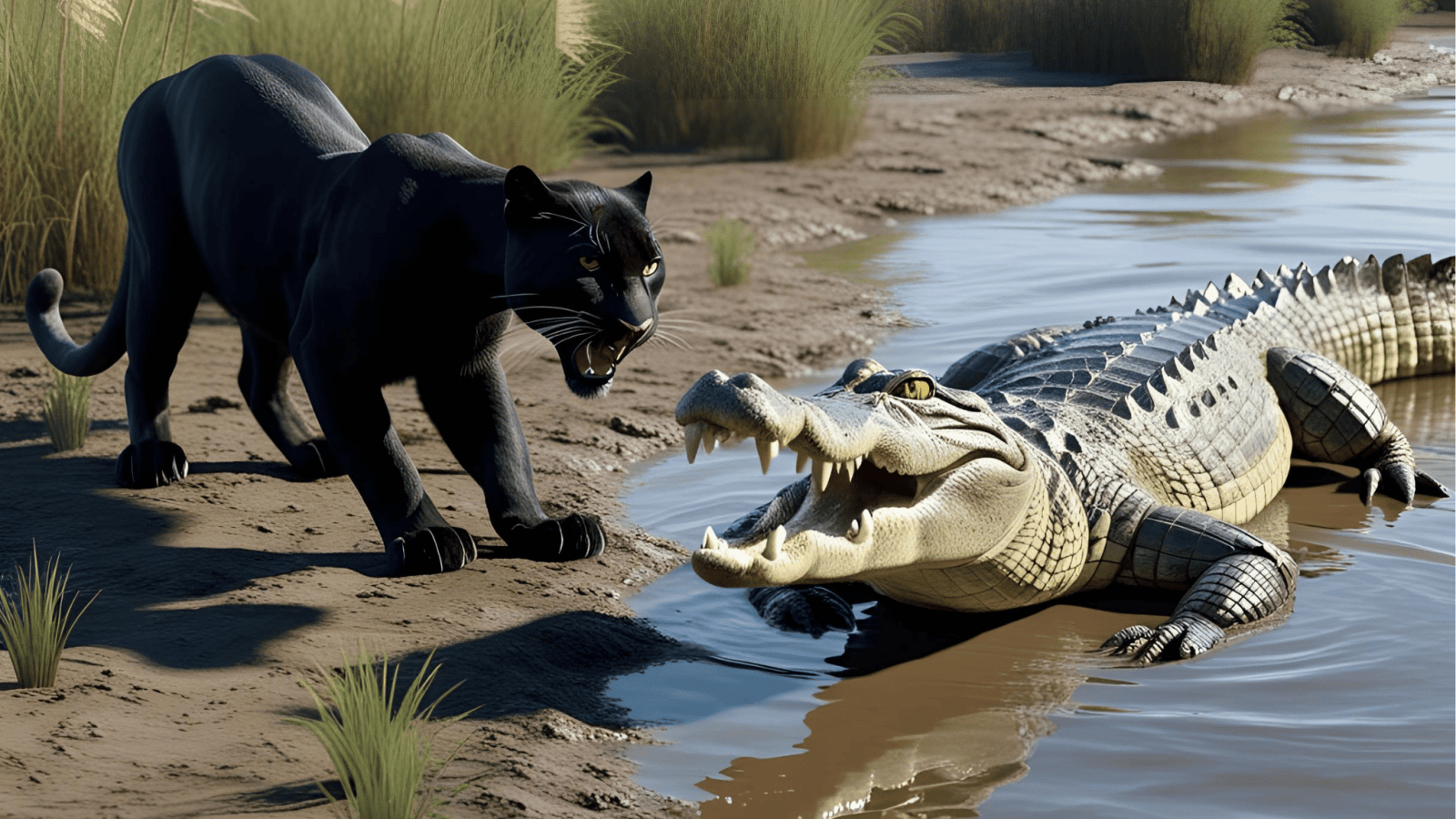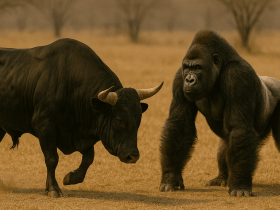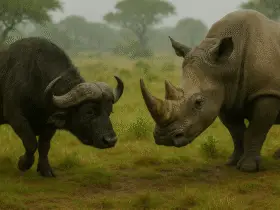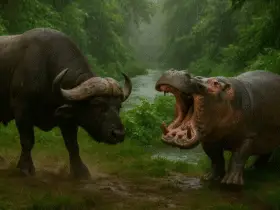In the deep jungle these two deadly predators Black panther vs Crocodile live side by side. But They rarely meet. Black panther hides in the trees and darkness , And when it comes to the crocodile they waits under the waters surface. What if they really meet? Will they fight each other? Who will win in this fight?
- Black panther ( Panthera pardus or Panthera onca, depending on region)
- Crocodile ( Crocodylus spp.)
Here I have bought you the scientific features of these two deadly predators. So by reading this article , I’m pretty sure that You will learn many new facts about Black panther vs Crocodile.
Enjoy!
1. Body Specifications
| Subtopic | Black Panther | Crocodile | Winner |
|---|---|---|---|
| Height at Shoulder | 60–70 cm | N/A (low-slung body) | Black Panther |
| Length | 1.6–1.9 m (body), up to 2.7 m incl. tail | 3–6 m depending on species | Crocodile |
| Weight | 45–100 kg (leopard), 60–120 kg (jaguar) | 250–1,000+ kg | Crocodile |
| Bone Density | Standard mammalian | Extremely dense, helps submerge | Crocodile |
| Muscle Mass | High (powerful limbs) | Moderate (mainly tail) | Black Panther |
| Skeleton Type | Endoskeleton, flexible spine | Rigid but strong | Black Panther |
| Tail Function | Balance & agility | Propulsion in water | Tie |
| Skin Toughness | Soft fur, vulnerable to bites | Thick armored scales (osteoderms) | Crocodile |
| Jaw Size | Proportional | Enormous, 60+ teeth | Crocodile |
| Overall Size Advantage | Medium-sized predator | Massive apex predator | Crocodile |
Winner: Crocodile (6–3–1)
2. Coat and Coloration
| Subtopic | Black Panther | Crocodile | Winner |
|---|---|---|---|
| Coloration | Melanistic black | Camouflage grey-green | Black Panther |
| Camouflage Ability | Excellent in forest & night | Excellent in muddy water | Tie |
| Patterning | Hidden rosettes (leopard/jaguar) | Non-patterned | Black Panther |
| Seasonal Adaptation | None | Minimal | Tie |
| Melanin Levels | High (melanism) | Low | Black Panther |
| UV Reflection | Low | Moderate | Black Panther |
| Skin/Scale Function | Thermoregulation via fur | Thermoregulation via basking | Tie |
| Visual Threat Display | None | Hissing, jaw gape | Crocodile |
| Fur Maintenance | Licking, grooming | None | Crocodile |
| Parasite Resistance | Moderate | High (thick skin) | Crocodile |
Winner: Black Panther (4–3–3)
3. Habitat and Range – Black panther vs Crocodile
| Subtopic | Black Panther | Crocodile | Winner |
|---|---|---|---|
| Geographic Range | Africa, Asia, Americas | Tropics worldwide | Crocodile |
| Habitat Type | Forests, grasslands | Rivers, lakes, estuaries | Tie |
| Altitude Tolerance | High (up to 4,000 m) | Lowlands only | Black Panther |
| Climate Preference | Tropical to temperate | Tropical/subtropical | Tie |
| Adaptability | High | High | Tie |
| Human Conflict Tolerance | Moderate | High | Crocodile |
| Urban/Edge Presence | Rare | Rare | Tie |
| Ambush Opportunities | Bushes, trees | Waterbanks, reeds | Tie |
| Territory Size | 10–40 km² | Shared water systems | Black Panther |
| Migration Pattern | Non-migratory | Non-migratory | Tie |
Winner: Tie (2–2–6)
4. Diet and Hunting
| Subtopic | Black Panther | Crocodile | Winner |
|---|---|---|---|
| Diet Type | Carnivore | Carnivore | Tie |
| Hunting Technique | Stalk-and-pounce | Ambush and clamp | Crocodile |
| Hunting Success Rate | 38–50% | Up to 70% | Crocodile |
| Prey Size Range | Small to medium mammals | Large mammals & fish | Crocodile |
| Ambush Skill | Excellent | Superior | Crocodile |
| Grip Strength | Strong jaws and claws | Exceptional (can’t be pried open) | Crocodile |
| Feeding Frequency | Daily to biweekly | Infrequent (huge meals) | Crocodile |
| Prey Dispatch Speed | Fast (throat bite) | Slow (drowning) | Black Panther |
| Food Caching | Sometimes (leopards) | No | Black Panther |
| Scavenging Tendency | Occasional | Frequent | Crocodile |
Winner: Crocodile (6–3–1)
5. Strength and Bite Force
| Subtopic | Black Panther | Crocodile | Winner |
|---|---|---|---|
| Bite Force (PSI) | ~1,100 PSI (jaguar), ~500 PSI (leopard) | Up to 3,700–5,000 PSI | Crocodile |
| Claw Strength | Extremely sharp, retractable | Blunt claws | Black Panther |
| Neck Strength | Strong for suffocation kills | Incredibly powerful | Crocodile |
| Jaw Opening Width | Moderate | Wide gape | Crocodile |
| Pulling Strength | High (can drag prey up trees) | High (can pull animals into water) | Tie |
| Lifting Strength | Can lift prey half their weight | Limited outside water | Black Panther |
| Resistance to Injury | Moderate | High (armored body) | Crocodile |
| Crushing Power | High (skull crush potential) | Extreme | Crocodile |
| Muscle Density | Compact & fast-twitch | Dense, especially in tail | Tie |
| Takedown Strength | Agile and lethal | Overwhelming in water | Crocodile |
Winner: Crocodile (6–3–1)
6. Speed and Agility – Black panther vs Crocodile
| Subtopic | Black Panther | Crocodile | Winner |
|---|---|---|---|
| Top Speed (Land) | 50–60 km/h | 12–14 km/h | Black Panther |
| Acceleration | Very fast | Very slow | Black Panther |
| Agility (Land) | Extremely agile | Poor | Black Panther |
| Agility (Water) | Poor | Very agile | Crocodile |
| Reflexes | Lightning-fast | Moderate | Black Panther |
| Jumping Ability | Up to 3 m high, 6 m long | Cannot jump | Black Panther |
| Climbing Ability | Excellent | Cannot climb | Black Panther |
| Stamina | Moderate | High (slow metabolism) | Crocodile |
| Turning Radius | Tight (land) | Tight (water) | Tie |
| Stealth | Exceptional | Exceptional (in water) | Tie |
Winner: Black Panther (6–2–2)
7. Senses – Black panther vs Crocodile
| Subtopic | Black Panther | Crocodile | Winner |
|---|---|---|---|
| Vision (Day) | Good | Moderate | Black Panther |
| Vision (Night) | Excellent (tapetum lucidum) | Poor | Black Panther |
| Hearing Range | Wide | Average | Black Panther |
| Olfactory Sense | Strong | Weak | Black Panther |
| Pressure Sensory Organs | Absent | Yes (in jaw scales) | Crocodile |
| Heat Detection | Some jaguars sense body heat | Yes (pressure & vibration) | Crocodile |
| Echolocation | None | None | Tie |
| Environmental Awareness | High | Very high in water | Tie |
| Reaction to Movement | Fast | Fast in water | Tie |
| Sensory Integration | Mammalian processing | Reptilian but specialized | Black Panther |
Winner: Black Panther (6–2–2)
8. Reproduction and Lifespan
| Subtopic | Black Panther | Crocodile | Winner |
|---|---|---|---|
| Gestation Period | 90–105 days | 80–90 days | Crocodile |
| Clutch/Litter Size | 1–4 cubs | 20–50 eggs | Crocodile |
| Parental Care | High (by mothers) | Moderate (mother guards nest) | Black Panther |
| Juvenile Mortality | High | High | Tie |
| Sexual Maturity | 2–3 years | 8–10 years | Black Panther |
| Lifespan (Wild) | 12–15 years | 45–70 years | Crocodile |
| Lifespan (Captivity) | 20+ years | 70+ years | Crocodile |
| Reproductive Frequency | 1 litter per 2 years | Once every 1–2 years | Tie |
| Breeding Strategy | K-selected | R-selected | Crocodile |
| Offspring Survival Strategy | Stealth and denning | Mass offspring | Crocodile |
Winner: Crocodile (6–2–2)
9. Social Behavior
| Subtopic | Black Panther | Crocodile | Winner |
|---|---|---|---|
| Social Structure | Solitary | Solitary | Tie |
| Territorial Range | 10–40 km² | Variable | Black Panther |
| Communication | Vocalizations, scent-marking | Hissing, low-frequency calls | Black Panther |
| Territorial Defense | Strong | Strong | Tie |
| Parental Roles | Mother only | Mother only | Tie |
| Play Behavior | Cubs play | Hatchlings don’t | Black Panther |
| Intelligence | High (problem-solving) | Basic instinctual | Black Panther |
| Memory | Strong (long-term memory) | Moderate | Black Panther |
| Intra-species Conflict | Rare | Frequent | Black Panther |
| Hierarchical Behavior | None | Rare dominance displays | Tie |
Winner: Black Panther (6–0–4)
10. Conservation Status-
| Subtopic | Black Panther | Crocodile | Winner |
|---|---|---|---|
| IUCN Status | Vulnerable (leopard), Near Threatened (jaguar) | Least Concern (some species) | Crocodile |
| Population Estimate | ~700,000 (all leopards) | >1 million (all crocs) | Crocodile |
| Main Threats | Habitat loss, poaching | Hunting, habitat loss | Tie |
| Legal Protection | CITES Appendix I/II | CITES Appendix I/II | Tie |
| Conservation Programs | Active | Active | Tie |
| Breeding Success | Moderate in zoos | High in captivity | Crocodile |
| Ecosystem Role | Top predator | Apex predator | Tie |
| Media Attention | High (charismatic) | Medium | Black Panther |
| Range Shrinkage | Ongoing | Minimal | Crocodile |
| Human Conflict | Moderate | High (man-eating) | Black Panther |
Winner: Crocodile (4–3–3)
⚔️ Face-to-Face Fight Analysis: Black Panther vs Crocodile
Scenario:
- Location: Near a riverbank in a tropical forest
- Initiator: The panther observes from covering themselves ; the crocodile waits Under the water.
- Fight Type: Land-based with a risk of water involvement
Outcome:
- On land, the black panther has superior speed, agility, and stealth. It can deliver a silent ambush . However, crocodiles are hard to damage, especially on their backs and flanks.
- If the crocodile gets a grip, the panther’s fight is over. A single bite and death roll can shatter bones.
- In water, the crocodile is virtually unbeatable.
Face-to-Face Winner: Crocodile
Final Winner:
Black Panther Vs Crocodile
| Category | Winner |
|---|---|
| Body Specifications | Crocodile |
| Coat and Coloration | Black Panther |
| Habitat and Range | Tie |
| Diet and Hunting | Crocodile |
| Strength and Bite Force | Crocodile |
| Speed and Agility | Black Panther |
| Senses | Black Panther |
| Reproduction and Lifespan | Crocodile |
| Social Behavior | Black Panther |
| Conservation Status | Crocodile |
✅ Overall Winner: Crocodile (5 categories)
❌ Defeated: Black Panther (4 categories + 1 Tie)
Why the Crocodile Wins
- Superior bite force (up to 5,000 PSI)
- Thick, armor-like skin is very hard to claws to tear up
- Aquatic dominance—once in water, the panther has no chance
- Size and mass advantage, especially with saltwater and Nile species
Why the Black Panther Loses
- Relies on agility and stealth, but can’t do lasting damage to a crocodile’s hide
- Poor water capabilities make escape unlikely if ambushed near water
- Much lighter and more vulnerable in a direct physical contest
References
- National Geographic – Crocodile Profile
- Panthera.org – Leopard & Jaguar Conservation
- IUCN Red List – Panthera pardus
- Smithsonian’s National Zoo – Jaguar Facts
- BBC Wildlife – Crocodile Behavior
Read More – Bear vs Black Panther : Who Would Win in a Wild Face-Off?






Leave a Reply